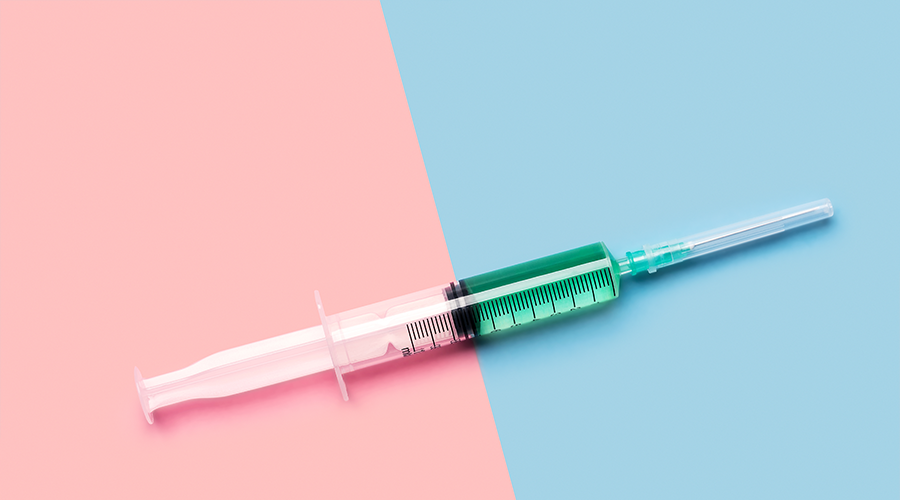Inside: Vaccines are ultra-sensitive to variable temperatures. And vaccine storage requires care and attention. Learn how to properly store and handle vaccines in your pharmacy to ensure their safety and efficacy.
You already know offering vaccines and immunizations can help your pharmacy grow.
Vaccines provide extra revenue and can drive more foot traffic to your independent pharmacy. And you probably already offer them considering that 74 percent of independent pharmacies do. (According to the 2017 NCPA Digest.)
But more operational requirements go hand in hand with the service. Namely, you have to figure out how to store and handle the vaccines—without ruining them.
Vaccines are incredibly sensitive to temperatures. They can go from good to bad in a heartbeat.
Improper storage and handling can reduce or destroy the potency of the vaccines, making them ineffective.
And that can cost your pharmacy thousands of dollars in inventory. Not to mention the immeasurable dollars from your patients’ lost trust.
Make sure you know the best practices for storing and handling vaccines. Here’s a condensed guide on vaccine storage and handling, adapted from a toolkit by the Centers for Disease Control and Prevention.
These Are the Best Practices for Receiving Vaccines in the Pharmacy
Vaccines need the right care from the time manufacturers create them to the time of administration.
Any exposure to unregulated temperatures reduces vaccines’ potency. And the exposure will eventually ruin them (even when it doesn’t look like it).
When the vaccines arrive at your pharmacy, attend to them immediately. Get them into proper storage.
Choose a specific staff member to handle vaccines. Make sure he or she understands the importance and timeliness of vaccine storage.
When the products arrive, make sure to look thoroughly at:
- Container (check for damages)
- Contents (confirm the contents match the package slip)
- Shipping temperature indicators (make sure the vaccine stayed at the correct temperature during shipping)
Pro Tip: The vaccine’s appearance can’t reliably indicate its viability. If you see signs of improper storage or handling, you can’t trust the vaccines.
These Are the Best Practices for Storing Vaccines in the Pharmacy
Where and how you store vaccines will influence their effectiveness.
You need to get the right equipment, use it in the right way, and maintain it properly.
What vaccine storage equipment to use
How you store refrigerated products matters. You either need to store vaccines in refrigerators or freezers, depending on the type.
Whichever equipment you choose to buy needs to maintain the required temperature range year-round. And the refrigerator and freezer need enough capacity to hold the year’s largest inventory.
Look for vaccine refrigerators and freezers designed specifically for storing vaccines. They’re built with advanced sensors and fans that work together to perfectly maintain proper temperatures. (Keep in mind they also cost more.)
Stand-alone refrigerators and freezers work more effectively than combination versions. If you have to use a combination unit, only use the refrigerator portion. The freezers in combined units often don’t maintain temperatures well enough.
Never use “dormitory style” units. (You know, the tiny fridges you took to college and filled with Redbull). They’re terrible at temperature control and will ruin the vaccines.
Where to put the vaccine storage equipment
Where you store your refrigerator and freezer matters less than what equipment you use or how you maintain it. But it still matters.
For your storage unit to cool correctly, it needs good air circulation.
When placing your vaccine storage unit, choose a well-ventilated room. And leave several inches of space on all sides.
What to put your vaccine storage units
Let’s state the obvious first. Don’t put your lunches or beverages in the vaccine fridge.
You also shouldn’t use the fridges to store other temperature-sensitive medications. If you must store items in the same fridge, never store medications in the same containers as vaccines. And don’t store them on the same shelf either.
The only items besides vaccines that can go into your vaccine storage units are water bottles. (Ones you won’t ever drink). Water bottles help maintain a constant temperature.
How to organize vaccines in the storage unit
Placing vaccines in the right spots in the fridge and freezer enable the best temperature control. It also protects vaccines from damage and prevents errors.
The CDC recommends following these best practices:
- Always store vaccines in their original packaging with lids closed
- Never store loose vials or manufacturer-filled syringes outside of their packaging
- Whenever possible, store diluent with the corresponding refrigerated vaccine
- Attach labels to shelves and containers to clearly identify the location of each type of vaccine and diluent
- Place vaccines and diluents in the center of the unit, two to three inches away from walls, ceiling, floor, and the door
- Avoid storing vaccines and diluents in any part of the unit that may not provide stable temperatures or sufficient air flow, such as directly under cooling vents, in drawers, or in shelves on the door
- Arrange vaccines and diluents in rows, allowing space between rows to promote air circulation.
- Place vaccines and diluents with the earliest expiration dates in front of those with later expiration dates
- Don’t pack a storage unit too tightly
These Are the Best Practices for Monitoring Vaccines in the Pharmacy
Now that you’ve stored the vaccines properly, they’ll likely maintain consistent temperatures.
But you still need to constantly monitor them. Remember, any exposure to high or low temperatures reduces the vaccines’ potency.
Ideal temperatures of refrigerated and frozen vaccines:
- Refrigerated vaccines (40 degrees Fahrenheit. But 36 to 46 is acceptable.)
- Frozen vaccines (Between -58 and 5 degrees Fahrenheit.)
What to look for in temperature monitoring equipment
You need to choose the correct thermometer to check the vaccine storage temperature.
The four main types of thermometers include:
- Standard fluid-filled
- Minimum-maximum
- Continuous chart recorder
- Digital data logger
Each type has strengths and weaknesses. But the CDC recommends using only a calibrated digital data logger (DDL). And one with a current and valid certificate of calibration testing.
DDLs provide the most consistent and reliable temperatures, even though they may be more difficult to install and use.
No matter what thermometer you choose, you’ll need to recalibrate it every year or two. Over time their accuracy decreases.
To ensure the most accurate reading, the CDC recommends these steps for installing the thermometer:
- Place the buffered probe of the DDL in the center of the unit with the vaccines surrounding it
- Place the DDL’s active digital display on the outside of the unit, so you can check temperatures without opening the door and disturbing the probe
- Set the DDL to measure and record temperatures no less frequently than every 30 minutes
Vaccine temperature monitoring best practices
Implement daily and weekly procedures to ensure you properly monitoring the temperature of vaccines. Dedicate specific staff members to monitor the vaccines to maintain consistency.
Perform these vaccine temperature monitoring practices every day:
- Document and record temperatures twice a day
- Check and record storage unit minimum and maximum temperatures at the start of each workday
- Check unit doors throughout the day and at the end of the day
- Post a vaccine temperature log on the door of each storage unit
Also, review temperature readings and file the information every week. (Keep this documentation for no less than three years). And, check the DDL website for any software notifications.
What to do about out-of-range temperatures
When temperatures rise or fall outside the appropriate range, it’s called a temperature excursion.
There’s no straightforward way to know whether the temperature excursions have rendered the vaccine unusable.
Manufacturers typically analyze three factors to determine the vaccines’ viability:
1. The magnitude of the temperature excursion
2. The total amount of time of the temperature excursion
3. Information about the vaccine
When you realize vaccines have experienced a temperature excursion, perform these three steps:
1. Keep the vaccines properly stored
2. Separate the vaccines from other vaccine supplies
3. Mark the vaccines as “Do Not Use” until you receive guidance from the manufacturer
How to Maintain Vaccine Storage and Temperature Devices
Regular maintenance of vaccine storage units and temperature equipment ensures their effectiveness. It also increases their lifespan.
Vaccine storage equipment maintenance
Check the airflow of your storage units. Make sure air doesn’t get in or out and that it circulates well.
Check these commonly-missed areas:
- Wear-and-tear on door seals
- Grime and dust on coils
- Bacteria growth inside the unit
Temperature device maintenance
Temperature monitoring devices all lose their accuracy over time.
The only way to counteract the loss is to recalibrate them often.
Test your temperature monitoring devices every one to two years and adjust as needed. Eventually, you’ll need to replace them altogether.
Make sure any replacements have a current and valid Certificate of Calibration Testing (also known as a Report of Calibration).
Now you can keep your valuable vaccine inventory safe and effective with these proper storage techniques.
 How to Make Immunizations a Pharmacy Profit Center
How to Make Immunizations a Pharmacy Profit Center
Learn proven strategies and insights to turn your pharmacy into immunization destination, including 20 practical tips to reap routine profits from your program. Read the story
A Member-Owned Company Serving Independent Pharmacies
PBA Health is dedicated to helping independent pharmacies reach their full potential on the buy-side of their business. Founded and run by pharmacists, PBA Health serves independent pharmacies with group purchasing services, wholesaler contract negotiations, proprietary purchasing tools, and more.
An HDA member, PBA Health operates its own NABP-accredited warehouse with more than 6,000 SKUs, including brands, generics, narcotics CII-CV, cold-storage products, and over-the-counter (OTC) products — offering the lowest prices in the secondary market.


 How to Make Immunizations a Pharmacy Profit Center
How to Make Immunizations a Pharmacy Profit Center









